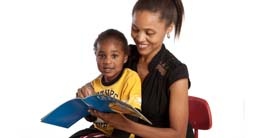 Do you find yourself wondering how to make reading a book with your child more meaningful? Do you have a hard time trying to get your child to WANT to read a book? Here are eight fun and easy ways to engage your child when reading a book and increase their pre-literacy skills and language skills.
Do you find yourself wondering how to make reading a book with your child more meaningful? Do you have a hard time trying to get your child to WANT to read a book? Here are eight fun and easy ways to engage your child when reading a book and increase their pre-literacy skills and language skills.
- Discussing Characters
- Before reading a story with your child, be sure to discuss all the characters!
- For example, in the book “Monster Trouble” there are 5 monsters on the front cover. You can describe all the different characters with your child and build their language skills. You can describe them by talking about what color they are, what size they are, how they might feel, what they might say, and so much more!
- Practice counting skills by counting all the characters. Count on your fingers to show a visual representation for your child.
- Describe what the word “character” is. You might tell your child that characters are the main person, animal, or thing in a story, movie, or TV show.
- Ask your child who their favorite character is and have them explain why they are their favorite!
- Story Prediction
- When reading a story to your child being very animated and using silly voices will keep the child engaged.
- After reading each page and before turning the page, ask your child what they think might happen next.
- Give a silly guess of what might happen next and ask the child if they think that is what is going to happen. For example, in the book “The Very Cranky Bear” the animals go into the dark scary cave and you may ask “What do you think they will find? Do you think they will find a Rainbow?!” then ask what the child thinks is in the cave!
- Social/Emotional Skills
- When reading a story, discuss how characters might be feeling and why they might be feeling that way. For example, in the story “The Very Cranky Bear” some of the characters look scared. You can talk with your child about why the characters might be scared. Look at the characters' faces and ask why they think they are feeling that way (“look he is not smiling, we know he is not happy”).
- Ask your child if they have ever felt that emotion you're discussing and talk about what made them feel that way!
- During a social problem in the story, talk about appropriate responses. For example, if in a story there is a character that is sad because no one is playing with them, you may ask your child “how can we make them happy again?”, or ask if this has ever happened in their life and what they did about it. This will help your child draw conclusions from their own social experiences, teach empathy skills, and help them take perspective.
- Expanding on a Child’s Utterance
- When your child makes a spontaneous utterance about something he/she might see in the book, praise them and expand on his utterance, for example, if they said “Dog!”, you might say “Yes! The big, furry dog!”
- Open-Ended Questions
- Throughout the story ask the child open-ended questions and try to relate the book to their life, for example when reading a story you can ask your child “What is happening on this page?”
- Object Function
- When objects appear in a story, discuss the function of the object. For example, in the story “Frog on a Log?” The goat is sitting on a coat. You may ask “Do we sit on a coat? Nooo! We wear a coat!”. Using facial expressions and having a different tone of voice will help engage your child and make it fun!
- Prepositions
- When reading a short story with your child, fun and easy way to target and practice using prepositions is to ask your child where certain objects are on a page. Be sure to use many different prepositions including “in, on, under, between, behind, in front of, etc.”
- You can practice this by using manipulatives of a child’s favorite toy and moving the toy all around to demonstrate all the different prepositions.
- Vocabulary
- Before reading the story with your child, find 2-3 words in the story that your child might not know. Talk about the words before reading and tell your child the definition and give an example of the word. For example, in the book “Monster Trouble,” you may discuss the word “exhausted”. You can say “exhausted is when you are very tired. I might be exhausted when I go to school all day!”
More preschool language and literacy information can be found here.









